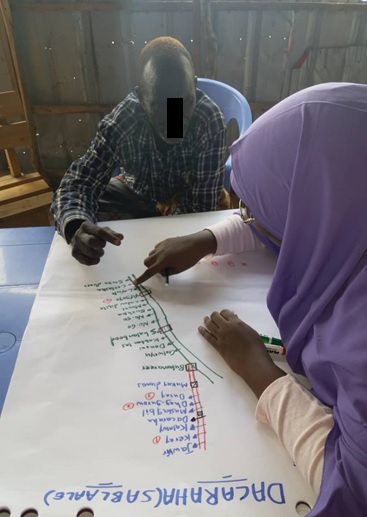Using Participatory Community Mapping to Improve Understanding of Migration in southern Somalia

Forced migration is common in southern Somalia, an area that continues to be affected by conflict, periodic droughts, and disease outbreaks. Following the drought and health crisis in 2017, the UCL Institute for Global Health (IGH) and Concern Worldwide have been working to improve understanding of the drivers of migration and its health consequences. Here, we describe our experience with using Participatory Community Mapping (PCM), one of the qualitative research tools used in our study.
PCM is the process of making maps that attempt to make visible the association between land and local communities by using cartography. Participatory maps show spatial information on the layout of an area, which is created jointly with local people. We used PCM technique in this study to provide an in-depth understanding of the factors and processes involved in determining how people migrated from areas in Lower Shabelle and Bay to camps for internally displaced persons (IDP) in the Afgooye Corridor, Mogadishu. We focussed on those that migrated during the during the drought and health crisis in 2017.
Using PCM we set out to answer the research questions:
- Which migration routes did people use?
- Why were these routes preferred?
- What happened during the journey that affected your health, and where did these events occur?
Data collection was undertaken by two local data collectors (both had prior experience in qualitative data collection) and supported by the lead researcher. Community Health Workers helped arrange the interviews and focus groups and locate participants. Potential participants was purposively sampled from the lists of camp residents that had been compiled as part of the Concern/UCL Nutrition and Mortality Monitoring System. They were then approached and invited to take part in the study.
Participants who had given informed consent were initially asked to take part in focus group discussions and/or interviews on the topic of migration and health. A purposively selected case series of IDPs, including both adult women and men, were then selected from these participants and invited to take part in the PCM exercise. The primary selection criteria for the PCM was based on their knowledge of the migration routes that they had used during their journey to the IDP camps.
We conducted six PCM exercises, each done with one individual participant or with several members of a family. The first two maps were constructed using large-scale printed Somalia maps. (Photo 1) However, we found that this process had limited success as the maps we were able to obtain and print did not have a high enough resolution to show all the villages where people were coming from or passing through on their journeys, so the resulting maps were somewhat sketchy. We therefore decided to use manual drawing and began each mapping exercise with a blank piece of paper. (Photo 2)

This approach proved much more successful in elucidating and illustrating the routes and transportation means that they had used to travel to the camps. It also revealed interesting information on the difficult decisions that families had to make during their journeys and some of the potential costs that they paid in terms of health outcomes.

Our experience, so far, with using PCM is that it is a useful additional tool to have available for use in qualitative studies. It helps capture information that would be hard to understand and visualise from a verbal narrative on its own, and helps the participant to recall and recount the migratory journey. As with other similar approaches, asking people to recount, and at some level re-experience, journeys that may have involved the loss of livelihoods and family members may be traumatic. Fully informed consent and sensitive handling of the mapping process is essential.
Stay updated
Sign up for our newsletter to receive regular updates on resources, news, and insights like this. Don’t miss out on important information that can help you stay informed and engaged.
Related articles
.png)

.png)
Explore Elrha
Learn more about our mission, the organisations we support, and the resources we provide to drive research and innovation in humanitarian response.